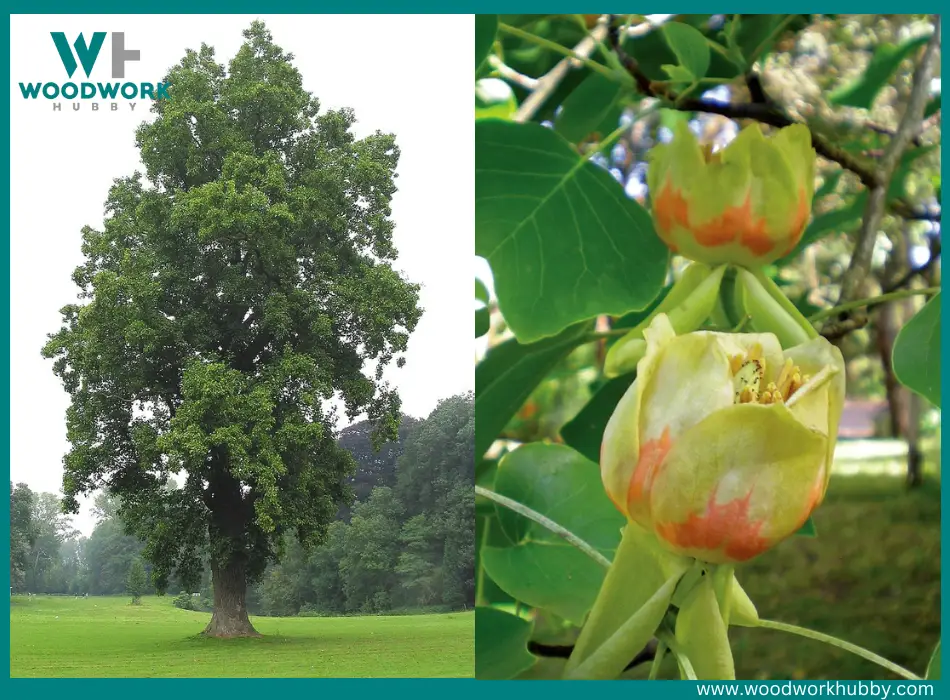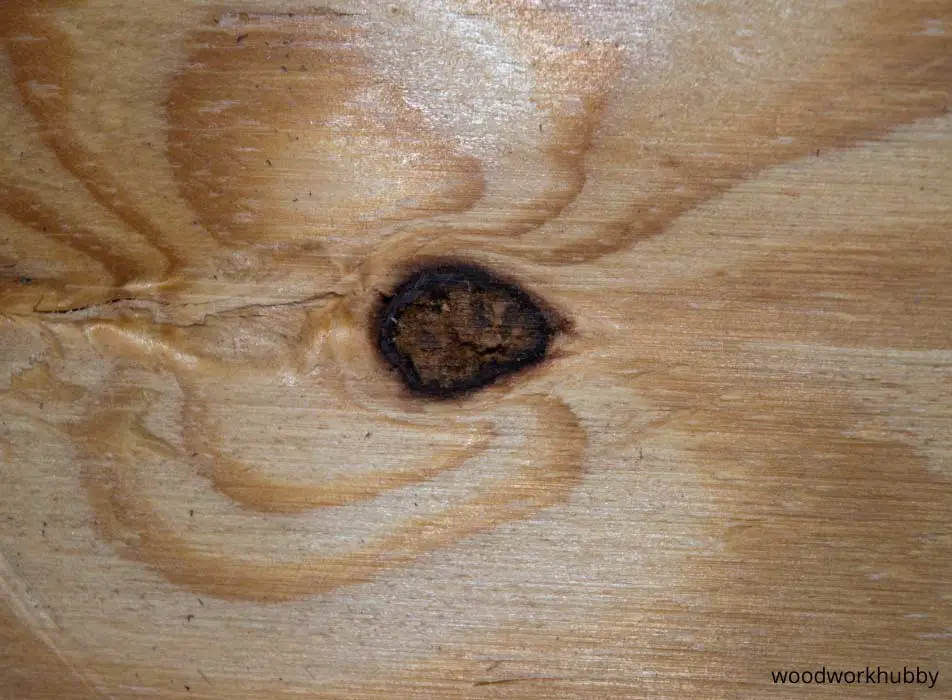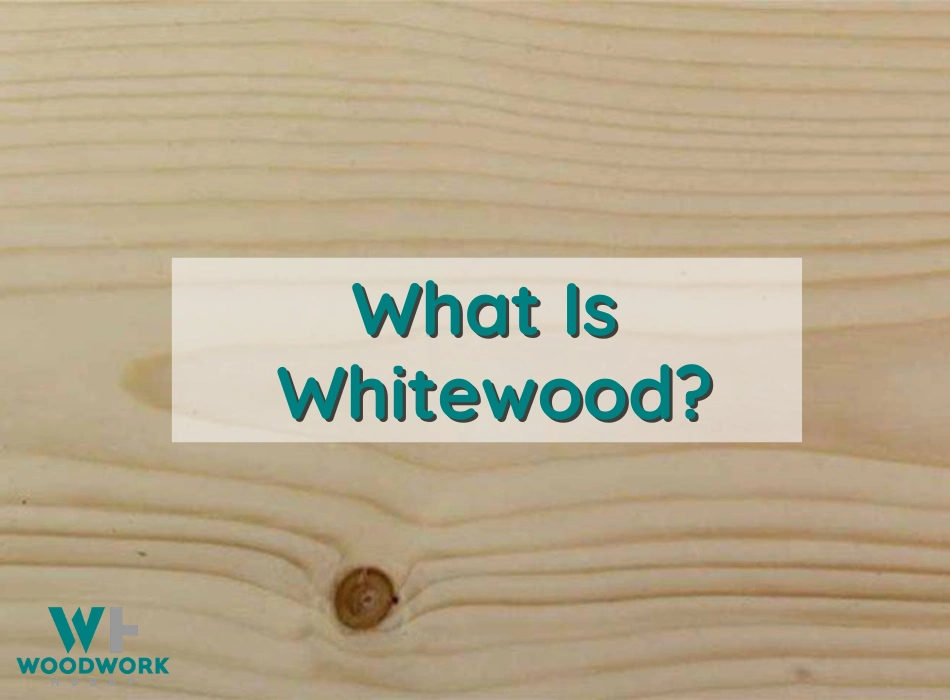Whitewood is a term that you will hear bandied about in woodworking supplier circles that requires some explanation, especially to the new woodworker. What makes the issue around Whitewood more confusing is that it can have different meanings in different locations. So, what is Whitewood, and how can you use it in your projects?
Whitewood comes from the Tulip tree and is light-colored wood very similar to Pine. It is sometimes stocked as cheap timber by suppliers as the difference between Whitewood and Pine is hard to tell.
Key Takeaways
- Whitewood is a type of softwood known for its light color and straight grain, making it versatile and ideal for a wide range of woodworking projects.
- Whitewood is not the same as pine; it refers predominantly to lumber produced from the tulip tree, while pine refers to various species in the Pinus genus.
- Pros of whitewood include its affordability, workability, rot resistance, and sustainability, but cons include inconsistent quality, limited durability, absorbency to water, and questionable sustainability claims.
- When comparing whitewood with pine, factors such as price (whitewood is generally less expensive), hardness (whitewood tends to be harder), color (creamy white vs. lighter shades), grain pattern (straight vs. more pronounced patterns), end grain (even vs. varied with knots), rot resistance (similarly susceptible), and sustainability can help in choosing the right wood for your project
Understanding Whitewood
Whitewood is a type of softwood known for its light color, with creamy white sapwood and light yellow or brown heartwood.
What is Whitewood?
Whitewood is a term often used to collectively refer to several light-colored woods, but mainly it refers to the lumber produced from the tulip tree. It’s popularly known for its creamy white to light yellow shade and soft nature.
This versatile wood, with its straight grain and quick growth rate, primarily thrives in regions stretching from Connecticut down toward Florida and as far west as the Mississippi River. The ease of working with Whitewood along with its natural resistance against termites makes it highly coveted among craftsmen for various projects including crafting furniture pieces to fine knife handles.
But like all things, it also comes with its own set of perks and drawbacks which are important considerations when choosing this wood species for your project.
Is Whitewood Pine?
Contrary to some misconceptions, whitewood is not the same as pine. While both types of lumber are classified as softwoods and share a light color, their characteristics, and origins differ significantly.

Whitewood refers predominantly to the tulip tree or American tulip tree (Liriodendron tulipifera), which is an eastern hardwood species found across locations from Connecticut to Florida and westward towards the Mississippi River.
On the other hand, pine refers to various species of coniferous trees that fall under the Pinus genus. The differences become more apparent when considering factors such as grain structure and workability—details that often influence woodworkers’ choice between whitewood and pine for their projects.
Is Whitewood Strong?
Whitewood has a strength rating of 8,600 psi and is generally not considered as strong as hardwoods like oak or maple. It possesses a lower density and hardness, which means it’s more susceptible to denting and damage from heavy impacts.
However, whitewood can still be quite strong for many woodworking applications, especially when used in appropriate contexts such as framing, sheathing, or crafting furniture with the right design and joinery techniques.
Video on the strength tests of various woods
The Whitewood Species
Whitewood comes from the tulip tree, which stands tall and strong throughout North America. Officially known as Liriodendron tulipifera, this mighty species is native across a broad swath of land that runs from Connecticut to Florida and stretches westward to the Mississippi River.
Remarkably fast-growing, these trees reach maturity within 15 years, making them a sustainable option for wood harvesting.
While ‘whitewood’ can sometimes be used as an umbrella term in lumberyards to include various light-colored woods like pine or fir, we’re focusing specifically on yellow-poplar here. This Eastern hardwood tree produces a timber that’s creamy white in its sapwood portion with heartwood presenting hues ranging from light yellow to brown.
In many big-box stores, Whitewood is classified as any coniferous wood such as fir or pine, and sometimes even spruce that the store can purchase in bulk cheaply and sell to their customers.
In this particular context, it is very difficult to know the characteristics of the wood that you are dealing with unless the species is denoted on the label or you can identify it yourself. If you need help on how to buy wood for woodworking.
In many hardware stores of big-box stores, you may see some abbreviations n the labels of whitewoods. You will find abbreviations such as SPF, SYF, or SYP, which can give you a clue as to the tree that the lumber comes from.
The SPF abbreviation indicates that the wood is either White Pine, Douglas Fir, or Spruce; this is the most common lumber type in these stores. The SYF grade denotes that the wood is from a Fir tree, while the SYP abbreviation is indicative that the wood is Southern Yellow Pine.
The species of trees that are offered under this generic term can differ widely depending on the local availability of the wood.
Video showing what Whitewood is
The Whitewood Species
When furniture manufacturer labels their creations as 100% Whitewood, they are more often than not referring to a specific tree, the American tulip tree or Liriodendron tulipifera. This tree is prolific across most of North America and is known by various common names in different locations.

This tree is often referred to as Yellow-poplar, even though it is not a poplar tree, and is also known as the fiddle tree, tulipwood, tulip poplar, and of course, Whitewood.
This tree has been named the state tree for Kentucky, Tennessee, and Indiana. It grows relatively fast, but the wood is strong and robust, which is uncommon in other fast-growing trees.
The wood that the tulip tree or the whitewood tree produces is a soft but fine-grained wood. The wood is often called poplar in the USA, which is derived from the name “yellow-poplar,” which is one of its names.
When this wood is exported outside of the USA, it is marketed as American tulipwood. It is a very stable wood that works easily and is cheap because the trees are fast-growing.
The characteristics of this wood are very similar to white pine, which is one reason why this wood is included in the generic whitewood term that is used by many lumberyards and big-box stores.

Can You Use Whitewood Outside?
Whitewood can be used outdoors for certain applications, but it is not the most durable choice for outdoor use. These softwoods are more susceptible to rot, decay, and insect damage when exposed to the elements compared to hardwoods like cedar, redwood, or teak.
When I use whitewood outdoors, I always treat it with appropriate protective finishes, such as exterior-grade paints, stains, or wood preservatives. Additionally, using pressure-treated whitewood can enhance its resistance to decay and insect infestations, making it a more viable option for outdoor projects like decking, fencing, or outdoor furniture.
What Can You Use Whitewood For?
Whitewood is a versatile wood that can be used for various practical purposes. Here are some common uses of whitewood:

Is Whitewood Good For Shelves?
Whitewood, like pine, can work well for shelves in certain indoor settings where it won’t face excess moisture or heavy loads. It’s cost-effective, readily available, and easy to work with.
However, it’s a softwood and can scratch or dent more easily than hardwoods. For added durability and a better appearance, sand and finish it with paint or a clear sealant.
If you need shelves for heavier items or in high-humidity areas, hardwoods or plywood might be more suitable due to their strength and resistance. The choice between whitewood and other materials depends on your specific project requirements and aesthetics.
The wood also works great for outdoor projects such as porch benches, picnic tables, and even smaller projects such as bird feeders and planter boxes. Discover the 10 best woods for a workbench.
Pros and Cons of Whitewood
Whitewood offers several advantages, including its affordability, versatility for various projects, and ease of workability. However, it is important to consider its absorbency to water and the potential for bowing or warping if not protected properly.
Pros of Whitewood
Whitewood lumber, also known as tulipwood or yellow poplar, offers several advantages for woodworking and construction projects.
Here are some of the key pros of using whitewood:
- Light color: Whitewood has a beautiful light color, with creamy white sapwood and light yellow or brown heartwood. This light shade makes it ideal for creating a bright and airy aesthetic in interior spaces.
- Versatility: Whitewood is a versatile wood that can be used for a wide range of projects. It is commonly used in furniture making, such as crafting dining room tables, home office desks, cabinets, coffee tables, and more. It can also be used for smaller items like picture frames, shelving, jewelry boxes, and cutting boards.
- Workability: Whitewood is relatively soft and easy to work with compared to harder woods like oak or hickory. It can be easily cut, shaped, and sanded to achieve the desired design. Its straight grain ensures smooth finishes on the surface.
- Affordability: Compared to exotic woods like Brazilian teak or cherry, whitewood offers an affordable alternative for those on a budget. It is also more cost-effective than domestic species like oak or hickory but still provides a high-quality finish.
- Rot resistance: One of the notable pros of whitewood is its natural resistance to termites and rotting. This eliminates the need for special finishes or chemicals to protect the wood from insect damage or decay when used indoors or outdoors.
- Sustainable option: Whitewood comes from fast-growing tulip trees found in various regions including Connecticut, New York, Ontario, Northern Ohio, and along the Mississippi River. Its quick growth makes it a sustainable option compared to slower-growing hardwoods.
Cons of Whitewood
Whitewood may have its advantages, but it’s important to be aware of the potential drawbacks as well.
Here are some cons to consider:
- Inconsistent Quality: The quality of whitewood lumber can be hit or miss. Some pieces may be straight and defect-free, while others may have warping, splitting, or even bark still attached.
- Limited Durability: Whitewood is not known for its exceptional durability. It is considered a softwood, which means it is more susceptible to dents, scratches, and general wear and tear compared to harder woods like oak or hickory.
- Knots and Defects: Whitewood can often have knots and other natural defects present in the wood. While some may find these characteristics charming and rustic, they can also weaken the overall strength and stability of the wood.
- Absorbent Nature: Whitewood has a tendency to absorb moisture more readily than other types of wood. This means that if not properly sealed or finished, it can be prone to warping, bowing, and rotting when exposed to water or high humidity levels.
- Limited Rot Resistance: Unlike certain hardwoods that naturally possess rot-resistant properties, whitewood is not particularly resistant to rotting. This means that if used outdoors or in damp environments without proper protection, it may deteriorate more quickly over time.
- Questionable Sustainability: While whitewood is often touted as a sustainable option due to its quick growth rate compared to slow-growing hardwoods, there are concerns about its true environmental-friendliness. Clear-cutting practices and transportation emissions associated with whitewood production can raise doubts about its sustainability claims.
- Lack of Character: Whitewood is prized by some for its clean appearance with minimal grain patterns or color variations. However, this lack of character can also be seen as a disadvantage by those seeking a more visually interesting or unique wood for their projects.
- Limited Usage: While whitewood can be used for a variety of indoor projects, it may not be the best choice for certain applications, such as heavy-duty furniture or flooring that requires greater strength and durability.
Comparing Whitewood and Pine
Whitewood and pine can be compared in terms of price, hardness, color, grain, end grain, rot resistance, and sustainability.
Whitewood vs. Pine – Price
When comparing whitewood and pine, one significant factor to consider is the price. Whitewood lumber generally tends to be less expensive than pine and other hardwoods like oak or hickory. This affordability makes whitewood an attractive option for those on a budget or looking for a more cost-effective wood choice for their projects.
Whether you’re building cabinets, coffee tables, or shelving units, opting for whitewood can help you save money without compromising on quality.
Whitewood vs. Pine – Hardness
When comparing whitewood and pine in terms of hardness, there are some key differences to consider. Pinewood, being a softwood, is generally softer than whitewood. However, it’s important to note that both types of wood can vary in hardness depending on the specific species and quality.
Whitewood, which comes from the tulip tree, is known for its relatively high Janka hardness rating compared to other softwoods. This means that it has good resistance to dents and scratches, making it suitable for various woodworking projects.
On the other hand, pine wood tends to have a lower Janka hardness rating than whitewood but can still be used effectively for less demanding applications. So when choosing between whitewood and pine based on hardness, it’s essential to consider the specific project requirements and expected wear and tear.
Whitewood vs. Pine – Color
When it comes to color, whitewood, and pine have distinct differences. Whitewood lumber has creamy white sapwood, while its heartwood is light yellow or brown in color. On the other hand, pine wood typically has a lighter shade overall, ranging from pale yellow to light reddish-brown.
These natural colors make both whitewood and pine suitable for various woodworking projects where aesthetics play an important role. Whether you’re building cabinets, coffee tables, or picture frames, the choice between whitewood and pine ultimately boils down to personal preference and the desired look for your finished piece.
Whitewood vs. Pine – Grain
When comparing whitewood and pine in terms of grain, there are some noticeable differences. Whitewood typically has a straight grain, which gives it a clean and uniform appearance. On the other hand, pine can have more pronounced grain patterns, including knots and swirls.
This makes pine a popular choice for those seeking a rustic or textured look in their woodworking projects. However, if you prefer a smoother and more refined finish, whitewood may be the better option.
Additionally, the straight grain of whitewood also makes it easier to work with when cutting and shaping pieces for your project.
Whitewood vs. Pine – End Grain
When comparing whitewood and pine, one important factor to consider is the end grain of the wood. Whitewood typically has a straight and even end grain, which makes it easier to work with in woodworking projects.
On the other hand, pine can have a more varied or irregular end grain, with knots and resin pockets that can sometimes make it more challenging to achieve clean cuts or smooth finishes. This is something to keep in mind when selecting wood for your projects, as the end grain can affect both the appearance and functionality of your final piece.
Whitewood vs. Pine – Rot Resistance
When it comes to comparing whitewood and pine in terms of rot resistance, there is a noticeable difference. While both woods are considered softer and more prone to damage compared to hardwoods like oak or teak, pine tends to be less resistant to rot than whitewood.
Whitewood, derived from the tulip tree, has natural properties that make it more durable against decay caused by moisture or fungi. On the other hand, pine wood may require additional treatments or finishes to enhance its rot-resistant qualities.
This makes whitewood a better choice for outdoor projects such as garden woodwork or wooden elements exposed to varying weather conditions.
Whitewood vs. Pine – Sustainability
Whitewood and pine are both considered sustainable wood options when managed responsibly. Whitewood trees, such as the tulip tree or American tulipwood, grow quickly and can regenerate rapidly after being harvested.
This makes whitewood a more environmentally-friendly choice compared to slower-growing hardwood species like oaks or hickories.
Pine, on the other hand, is also known for its sustainability. It is a coniferous wood that grows abundantly in many regions, including Connecticut, New York, Ontario, northern Ohio, and Florida.
Although it may not grow as fast as whitewood, pine is still a viable option if sustainability is one of your top priorities.
How to Identify Quality Whitewood
When selecting whitewood for your projects, it’s important to identify quality wood that will meet your needs. Here are some key factors to consider:
- Look for straight grain: High-quality whitewood will have a straight and even grain pattern, which indicates stability and strength.
- Check for knots: Knots are common in whitewood, but they should be small and tightly closed. Avoid boards with loose or large knots, as they can weaken the wood.
- Examine for mineral streaks: Whitewood may have mineral streaks running through the grain. While these streaks can add character to the wood, excessive or dark streaks may indicate lower quality.
- Consider moisture content: Quality whitewood should have a low moisture content to minimize the risk of warping or splitting. Use a moisture meter to ensure the wood is properly dried.
- Feel the weight: A high-quality piece of whitewood will feel solid and substantial in your hands. Lighter boards may indicate lower density or less durable wood.
- Inspect for defects: Carefully examine the surface of the wood for any visible defects such as cracks, splits, or insect damage. Choose boards that are free from major flaws.
Best Practices for Cutting and Finishing Whitewood
When working with whitewood, it’s important to follow these best practices for cutting and finishing:
- Use a sharp saw blade or router bit to ensure clean cuts and reduce splintering.
- Consider using a pre-stain conditioner to prevent blotching when applying stain to whitewood.
- When sanding whitewood, start with coarse grit sandpaper and gradually move to finer grits for a smooth finish.
- Clean the surface of the whitewood before applying any finishes to remove dust or debris that could affect the final result.
- When applying paint or stain, use water-based products for easier cleanup and reduced fumes compared to oil-based products.
- Allow adequate drying time between coats of paint or stain to ensure proper adhesion and a professional-looking finish.
- Consider using sealer or protective coatings on outdoor projects made from whitewood to enhance durability and rot resistance.
- For more intricate woodworking projects, consider using hand tools like chisels or carving knives for precise detailing.
Whitewood and the Outdoors
As an avid woodworker and outdoor enthusiast, I’ve always been intrigued by the versatility of whitewood when it comes to outdoor projects. Whether you’re building porch benches, picnic tables, bird feeders, or planter boxes, whitewood is a fantastic choice.
With its natural resistance to termites and rot, you can rest assured that your creations will withstand the elements for years to come.
One of the key advantages of using whitewood for outdoor projects is its affordability compared to other types of wood. Unlike expensive teak or exotic hardwoods, whitewood allows you to create beautiful pieces without breaking the bank.
Types Of Whitewood
The most common types of whitewood are:
- Pine
- Spruce
- Fir
- Cedar (in some cases)
- Hemlock (in some cases)
- Poplar (sometimes referred to as white poplar)
Conclusion – What Is Whitewood?
In conclusion, understanding whitewood is essential for anyone looking to embark on woodworking projects. With its light color and straight grain, whitewood offers versatility and affordability that make it a popular choice.
From furniture making to outdoor projects, this sustainable wood option provides the perfect balance of durability and workability. By considering the pros and cons outlined in this guide, you can confidently choose whitewood as your ideal wood for any project.
FAQs
1. What is whitewood and how is it different from other types of wood?
Whitewood refers to a type of softwood that comes from various species, including spruce, pine, and fir. It is commonly used in construction projects due to its affordable price and decent strength-to-weight ratio. Unlike hardwoods, which come from deciduous trees, whitewoods are sourced from evergreen coniferous trees.
2. What are the advantages of using whitewood for my projects?
There are several advantages to using whitewood for your projects. Firstly, it is usually more budget-friendly compared to hardwood options like oak or maple. Secondly, it has good workability properties such as ease of cutting, shaping, and nailing. Lastly, it takes well to staining or painting if you want to customize the appearance of your finished project.
3. Are there any downsides or limitations when working with whitewood?
While there are benefits to using whitewood, there are also some considerations to keep in mind. One limitation is that due to its soft nature, it may dent or scratch more easily than harder woods over time. Additionally, because it comes from fast-growing trees with less dense fibers compared to hardwoods like walnut or mahogany, it may not offer the same level of durability or long-term stability.
4. How Do I Choose The Ideal Whitewood for my Specific Project?
When choosing the ideal whitewood for your project, consider factors such as intended use (e.g., indoor furniture versus outdoor decking), desired aesthetics (grain pattern/color), and budget constraints. It’s also helpful to consult with a knowledgeable lumber supplier who can provide guidance based on your specific needs and preferences.
Is Whitewood a Hardwood?
Whitewood is not a hardwood; it’s a softwood. Whitewood includes species like pine, spruce, and fir, known for their lighter color and lower density compared to hardwoods. Softwoods are typically from coniferous trees, while hardwoods come from deciduous trees, and they have different uses in woodworking.
Is Whitewood Hard or Soft?
Whitewood is soft as it is a softwood.
Is Whitewood Good For Furniture?
Whitewood is a good choice for furniture as long as the furniture is kept indoors. Whitewood is soft and easy to work but more than strong enough to make furniture from.
Is Whitewood Good For Outdoors?
Whitewood is generally not the best choice for outdoor use. It’s a softwood and can be susceptible to rot and insect damage when exposed to the elements. To use whitewood outdoors, it needs to be properly treated with protective finishes and sealants.
Is Whitewood Pine?
Whitewood is often a term used to refer to various types of softwood, with pine being one of the common species categorized under the term “whitewood.” So, in many cases, whitewood can indeed be pine.
How To Tell If You Are Buying Whitewood or Pine?
- Inspect the Color: Whitewood typically has a lighter color compared to many other wood types, including pine.
- Examine the Grain: Whitewood often has a straight, even grain pattern, while pine can have a more pronounced grain with occasional knots and irregularities.
- Ask the Seller: Don’t hesitate to ask the seller or supplier for clarification. They should be able to provide information about the wood they are selling and confirm whether it’s whitewood or pine.
- Feel the Weight: Pine is generally denser and heavier than whitewood. If you can compare the weight of the wood to a known piece of pine, it may help confirm the type of wood.




